Translate this page into:
Post Insertion Complaints in Complete Dentures – A Never Ending Saga
*Author for correspondence
This article was originally published by Informatics Publishing and was migrated to Scientific Scholar after the change of Publisher.
Abstract
Removable Complete Dentures still exist as the treatment option of choice for majority of edentulous patients. The anatomical and adaptational limitations associated with this modality often refrains a clinician from attending patients of geriatric group. Most of the complaints associated with complete dentures are actual and not psychological, contrary to the belief of most clinicians. This article attempts to cover most of the common complains of complete denture wearers along with their possible causes and remedies.
Keywords
Dental Complaints
Denture Follow Up
Denture Troubleshooting
Post Insertion Problems
1. Introduction
With advancements made in medical science, the life expectancy of human beings is steadily increasing. Along with the increased average life span of our population, the number of geriatric patients requiring dentures for replacement of missing teeth is also increasing. Although a revolution had taken place in the field of Implantology, removable dentures still plays an important role among majority of the patients in our country and thus is an indispensable treatment option.
Fabrication of complete dentures is dependent on technical, biological, and psychological interplay between the clinician and the patient. Paramount to the patient is factors as esthetics, comfort, and masticatory ability. The overall success of complete denture therapy depends on patient’s comfort and acceptance of the dentures. The problem with complete dentures is that they are foreign bodies. Though they are compatible with oral environment, they require learning for tissue accommodation. Tissue response varies from individual to individual and from time to time in the same individual. Factors of general health, resistance to disease, pain threshold, diabetes, hyper tension; habits such as smoking, medication of long duration, anemia, wasting and old age alter tissue response and create problems associated with denture use.
Majority of the problems associated with denture are real and not psychosomatic or psychological. A careful analysis based on a thorough understanding of usual and unusual tissue response as well as of the basic principles of complete denture prosthesis is crucial in eliminating the problems associated with complete denture use. Many essentially satisfactory dentures are ruined by hasty indiscriminate alteration by grinding the denture base and teeth.
1.1 Why should there be a problem in adjusting to Complete Dentures?
It can be said that complete denture treatment is an unnatural treatment of oral tissues left over after loss of teeth. Nowhere in the evolution cascade, do we find a dentition similar to removable dentures.
The dentures act as foreign body which sandwiches the oral mucosa against the hard bone.
It may be understood that the oral tissues have not evolved to accept the ravages of such large foreign bodies. It is therefore natural that an initial copious flow of saliva is a proof of rejection of the oral tissues of invading agency.
The dentures are simply placed on tissues without anchors and the patient is expected to acquire neuromotor skills in holding them. In this exercise, the dentures are expected to remain seated during various functional excursions.
The neuromuscular attainment of skill is more easily said than done since the learning potential of patients varies at every age level and hence in advanced age the patients face a situation of tight rope walk.
It is to be reckoned that the denture bearing area present varying degrees of different morphology and altered physiology. In fact, the dentures reveal a lot of skidding effect adding to the problem of sensitive oral mucosa.
Similarly food habits manifest diversity to a point that patient needing to use the dentures successfully, has to accept the changes in life style.
Emotional disturbances and more so in advancing age are yet another manifestation that causes irritation of tissues and resulting in tissue loss.
2. Factors Causing Post Insertion Problems
Factors causing Post Insertion Problems may be grouped into three classes.
Clinical Factors.
Technical Factors.
Patient Adaptation Factors.
2.1 Clinical Factors
Clinical Factors are again subdivided into:
arising from decreased retention forces
arising from increased displacing forces
2.1.1 Arising from Decreased Retention Forces
| Symptoms/clinical findings | Cause | Treatment | ||
|---|---|---|---|---|
Lack of peripheral seal 
|
Border under-extension in Depth. Border under extension in width. Often a particular problem in disto-buccal aspects of upper periphery which may be displaced by buccinator on mouth opening. Posterior border of upper denture | Add softened tracing compound to relevant border, mould digitally and by functional movements by patient. Replace compound with acrylic resin. As a temporary measure a chair side reline material may be used | ||
Inelasticity of cheek tissues 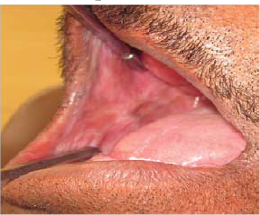
|
Consequence of ageing process; scleroderma, submucous fibrous | Mould denture borders incrementally using softened tracing compound as functional movements are performed - aim to slightly under-extend depth and width of denture periphery. | ||
| Air beneath impression surface. Denture may rock under finger pressure. May see gap between periphery of flange and ridge. Occlusal error subsequent to warpage | Deficient impression. Damaged cast. Warped denture. Over- adjustment of impression surface. Residual ridge resorption. Undercut ridge. Excessive relief chamber. Change in fluid content of supporting tissues |
Reline if design parameters of denture satisfactory, otherwise remake as required. | ||
| Xerostomia Reduces ability to form a suitable seal | Medication by many commonly prescribed drugs, irradiation of head and neck region, salivary gland disease | Design dentures to maximise retention and minimise displacing forces. Prescribe artificial saliva where appropriate | ||
| Neuromuscular control Essential for successful denture wearing: speech and eating difficulties occur | Basic shape of denture incorrect, lower molars too lingual; occlusal plane too high: upper molars buccal to ridge and buccal flange not wide enough to accommodate this; lingual flange of lower convex. Patient of advanced biological age, | Correct design faults by, eg removal of lingual cusps of posterior teeth. Flatten polished lingual surface of lower from occlusal surface to periphery, fill sulci to optimal width. May require remake to optimal design. |
||
2.1.2 Arising From Increased Displacing Forces
| Symptoms/clinical findings | Cause | Treatment |
|---|---|---|
Linear erythema at depth of vestibule; lower denture jumps up on opening the mouth, frequent ulceration in vestibular area; upper denture falls on opening the mouth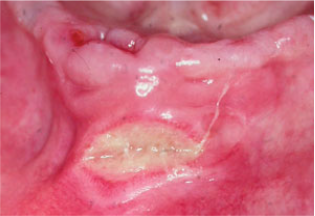
|
Over-extended denture borders in length Extended lingual flanges causes lower denture to lift on tingue movement. Extended distobuccal flange of upper denture cause it to fall on opening or cheek soreness occurs. Thick upper and lower labial flanges may produce displacement during muscle activity |
Use disclosing material to identify the overextensions and reduce them judiciously. Always polish the borders again after reduction is complete. Check borders of record rims and trial dentures at the appropriate stages. |
Lips and cheek appear puffed out. In lower, the buccal flange may be palpated lateral to external oblique ridge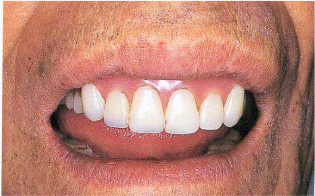
|
Overextension in width Error at jaw relation or try-in stage. Wax-up errors | Reduce width of the flanges. Remake the dentures if error is gross. |
| Denture rocks on supporting tissues. Dentures seats but lift up on releasing digital pressure |
Poor fit to supporting tissue Impressioning errors, especially in retromylohyoid area | Reline the denture if no other problem; otherwise remake. |
Denture not in optimal space
|
Teeth set up lingual to ridge, convex buccal and lingual flanges. Posterior occlusal table too broad, causing tongue trapping | Reduce the lingual cusps and lingual surface from appropriate area. If that does not suffice the problem, reset the posterior teeth or remake the dentures |
2.2 Technical Factors
| Symptoms/clinical findings | Cause | Treatment |
|---|---|---|
Related to impression surface and present as discrete painful areas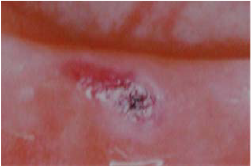
|
nodules or sharp ridges of acrylic on the intaglio surface. | Locate with finger, or snagging dry cotton wool fibres. Use disclosing material to identify smaller projections. Trim the extra acrylic elevations. |
| Pain on insertion and removal of dentures. Inflamed ridge slopes | Insufficient relief to denture in the region of undercuts. | Use disclosing material to adjust in region of ’wipe off ’. Alter the path of insertion and removal- pushing the lower denture distally and then removing can reduce the abrasions. |
Areas painful to pressure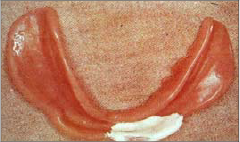
|
Pressure areas resulting eg from faulty impressions, damage to working cast, warpage of denture base. | Use disclosing material to precisely trace area to be relieved. If severe, remake the denture. |
| Soreness over mylohyoid ridge; denture lifts on protruding the tongue; pain on swallowing. |
Over-extension of lingual flange. Over-extended lower impression: instructions to laboratory not clear or non-existent | Determine position and extent of over-extension using disclosing material and relieve accordingly. |
Generalised pain over denture -supporting Area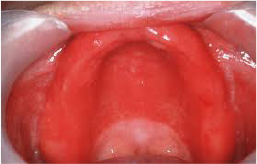
|
Under-extended denture base - may be the result of over- adjustment to the periphery, or impression surface. Check vertical occlusal dimension. | Border mould the peripheries and reline the denture in order to extend its support area. If increased VDO, remake the denture. |
| Impingement of soft tissue between denture base and bony structures. Sore throat, difficulty in swallowing | Lack of relief for frena or muscle attachments | Relieve with aid of disclosing material. Discontinue the denture till healing occurs. |
2.3 Patient Adaptation Factors
| Symptoms/clinical findings | Cause | Treatment |
|---|---|---|
| Noise on eating/speaking May be apparent on first insertion or may appear as resorption causes dentures to loosen |
May be lack of skill with new dentures, excessive OVD, occlusal interference, loose dentures, or poor perception of patient to denture wearing | Where unfamiliarity present, reassurance and persistence recommended. Address specific faults or remake as required |
| Eating difficulties Dentures move over supporting tissues |
Unstable dentures. Check that retentive forces are maximized and displacing forces minimized and all available support has been used | Construct dentures to maximise retention and minimise displacing forces |
| ’Blunt teeth’ | Broad posterior occlusal surfaces which replaced narrow teeth on previous denture. Non anatomical type teeth used where cusped teeth previously used | Where non-anatomical teeth used, careful explanation of rationale is required, may be possible to reshape teeth. Routine use of narrow tooth moulds recommended. |
| ’Jaws close too far’ | Lack of OVD, so that mandibular elevator muscles cannot work efficiently | May increase up to 1.5 mm by relining but if deficiency is greater, remake denture |
| ’Cannot open mouth wide enough for food’. May be speech problems and facial pain especially over masseter region | Excessive OVD | Can remove up to 1.5 mm from occlusal plane by grinding, but if more is required, remake dentures |
| Speech problems Uncommon, but presence is of great concern to patient. May affect sibilant (eg s), bilabial (eg p,b), labiodental (eg f.v) |
Cause may not be obvious. May be unfamiliarity - check that problem not present with old dentures | Check for vertical dimension accuracy, and that vertical incisor overlap not excessive. Palatal contour should not allow excessive tongue contact or air leakage - |
| Gagging May be volunteered by patient prior to treatment, or apparent at commencement of treatment or on insertion of denture 
|
May be loose dentures, thick distal border of upper denture: lingual placement of upper posterior teeth or low occlusal plane causing contact with dorsal aspect of tongue |
Construct dentures to maximise retention and minimise displacing forces. Use ’condition’ appliance |
| Appearance Complaints may arise from patient or relatives. Common complaints include: shade of teeth too light or dark; mould too big/ small; arrangement too even or irregular or lacking diastema |
Patient failed to comment at trial stage, or has subsequently been swayed by family or friends. Perhaps the change from the old denture to the replacement denture is too sudden/severe |
Accurate assessment of patient’s aesthetic requirements. Ample time for patient comments at trial stage. Use any available evidence to assist - photographs, previous dentures. Consider template prosthesis |
Too much visibility of teeth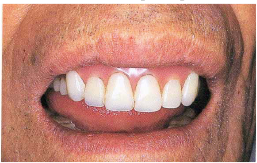
|
Level of occlusal plane unacceptable, teeth placed on upper anterior ridge and no/poor lip support | Accurate prescription to laboratory via optimally adjusted occlusal rim |
Creases at corners of mouth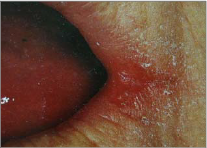
|
Labial fullness and anterior tooth position may be inaccurate. OVD may be inadequate | Adjust tooth position as appropriate. If OVD problem, re-register jaw relations |
3. Difficult Denture Birds
The concept of difficult denture birds was described by Koper (1988). The difficult denture birds is defined as a problem denture patient with much experience as a recipient of various kind of dental therapy. They are individuals who complain, have pain, are hostile, tense, anxious, and unhappy people. They often exhibit regressive behavior and transfer many of their fear and frustrations to their mouth and face.
Some of the categories that most of the patients could be described within are as following:
1. Whittling Denture Dove/Denture Swellers
These are passive songsters who fill the dentist with nothing but praise until the dentures are completed.
They can hardly wait to get the finished dentures home and to the work bench. At the slightest of discomfort they start smoothening or evening up of dentures with sand paper of emery.
Denture swellers collect self cure resin and then start adding self cure material to suit their facial contour often leading to destructive results.

2. Bruxing Booby
After wearing down his natural teeth away, he brings a life time of experience and over developed masseter and pterygoid muscle to the encounter with the denture. The mutilation resulting due to his over loaded and abused denture bearing tissues brings howls of pain and threats of violence to the dentist.
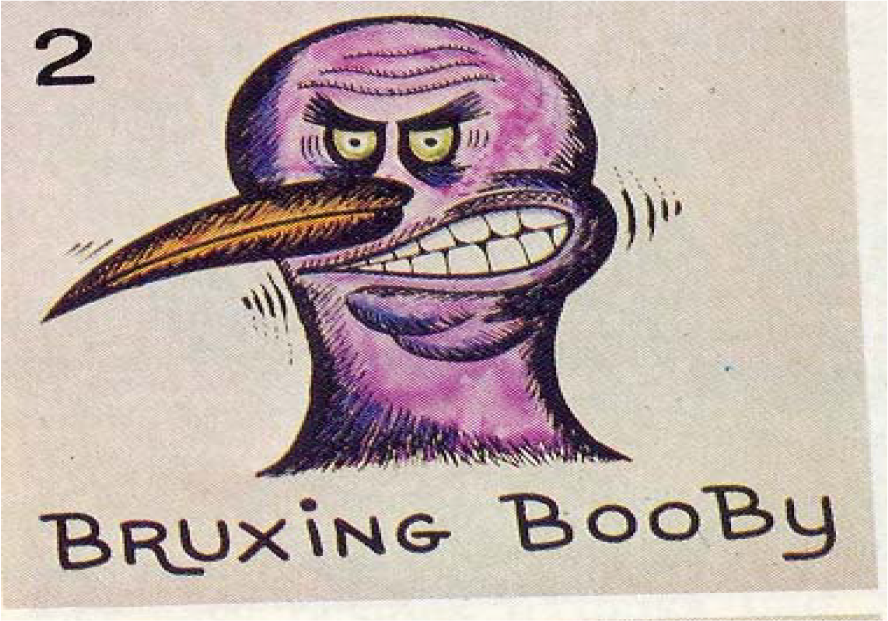
3. Gagging Grackle
The gagging grackle dares the dentist to make dentures that he cannot get rid of himself.
The novice gagger will upchuck during impression stage and alert the dentist there by alerting the dentist soon. Occasionally he uses his hand to remove the dentures.
The experienced gagger learns that it is more fun to see how far one can toss the dentures when they are complete. He hides the fact that he cannot bear the denture in his mouth for more than 15 minutes.

4. Birds of Paradise
Also called as warm bottomed warbler
The members of this species are all female who are completely satisfied with their dentures. They have other problems which they think that only a dentist can solve. Be sure to keep one assistant with dentist all times.
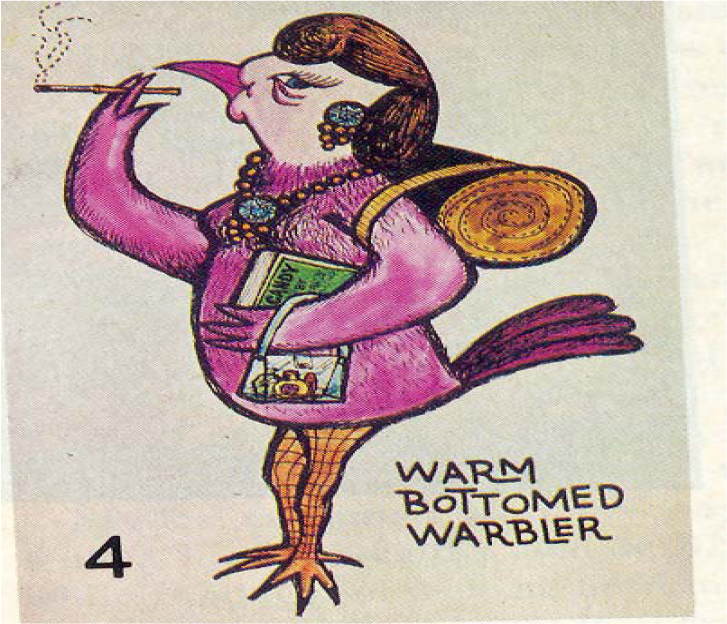
5. No Pay Jay
The no pay jay is an expert at getting something for as little as possible. His way of life is based on the premise that anyone can pay for the dentures and use them, but the real skill is in getting the dentures and not paying for it. Most often they delay payment of all but a token retainer. Request for payment is always accepted and deferred for one reason or other. As soon as dentures are placed, the trouble begins. Nothing is right, everything turned out differently than what it looked at the time of try-in.
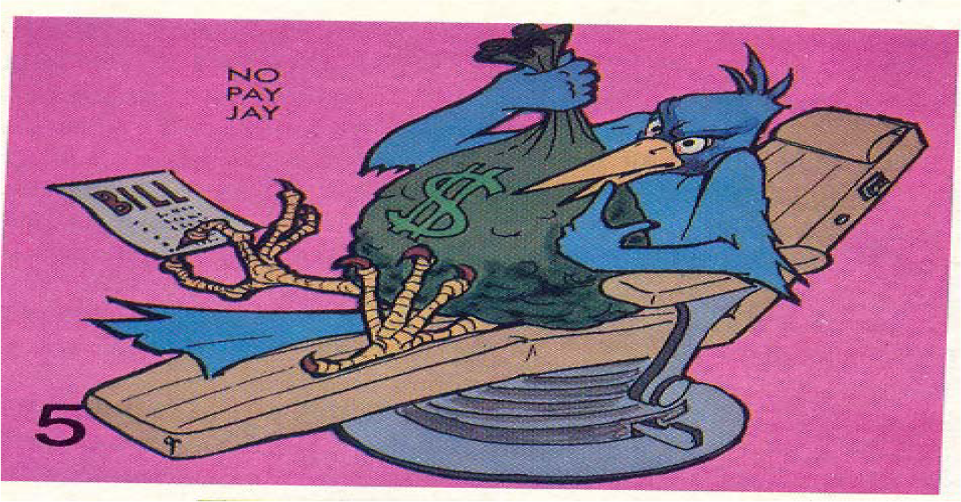
6. Sweet Sue Sparrow
These are the most prolific breeders in difficult denture bird family. They know that the cost of defense, the aggravation involved, and the dentist’s time away from practice often leads to unjustified settlements.
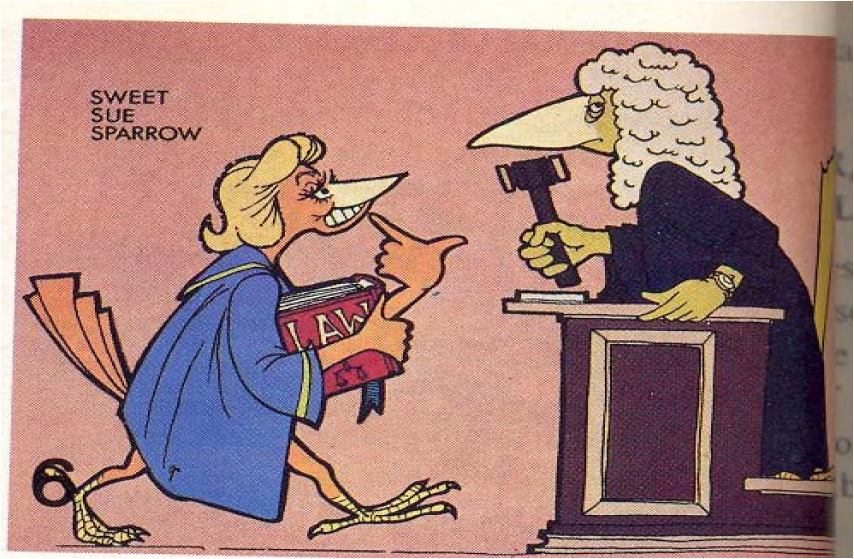
7. Aphasic Tern
These patients have great trouble in communicating with the dentist during treatment. But as soon as the dentures are completed they become voluble experts of explaining every detail of countless problems.
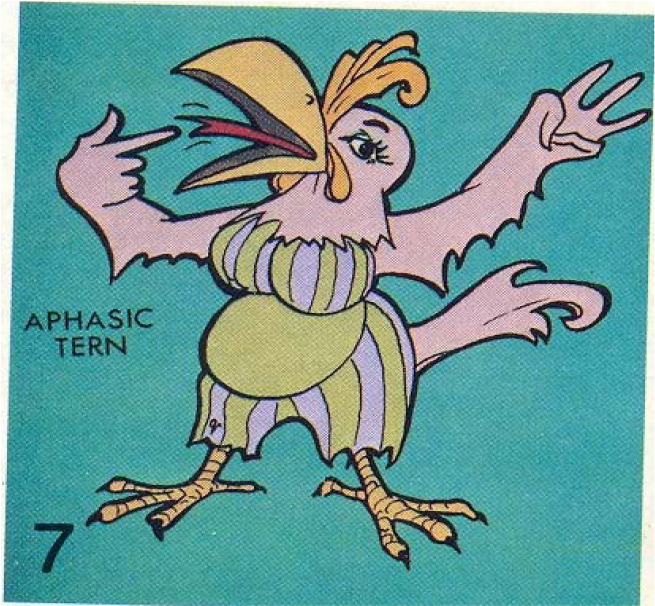
8. Pocket Wearing Wren
He is fine happy male songster who just wants to be left alone. He has only one set of dentures and never comes in for adjustments because he hardly wears them. The occupation of this species is important so that it allows him to keep his dentures in his pocket and work.

4. Conclusion
A thorough knowledge of factors involved in construction of complete dentures is essential before attempting post insertion check up.
Without having this knowledge, any attempt made to solve post insertion problems will lead to haphazard reduction of prosthesis which will compromise its purpose, also leading to repeated patient visits and dissatisfaction of the patient.
Also the role of patient in getting used to the prosthesis should be clearly explained to him rather than simply heeding to patient demands.
References
- (1988) Difficult denture birds–New sightings. The Journal of Prosthetic Dentistry. ;60(1):70-74.
- [Google Scholar]






